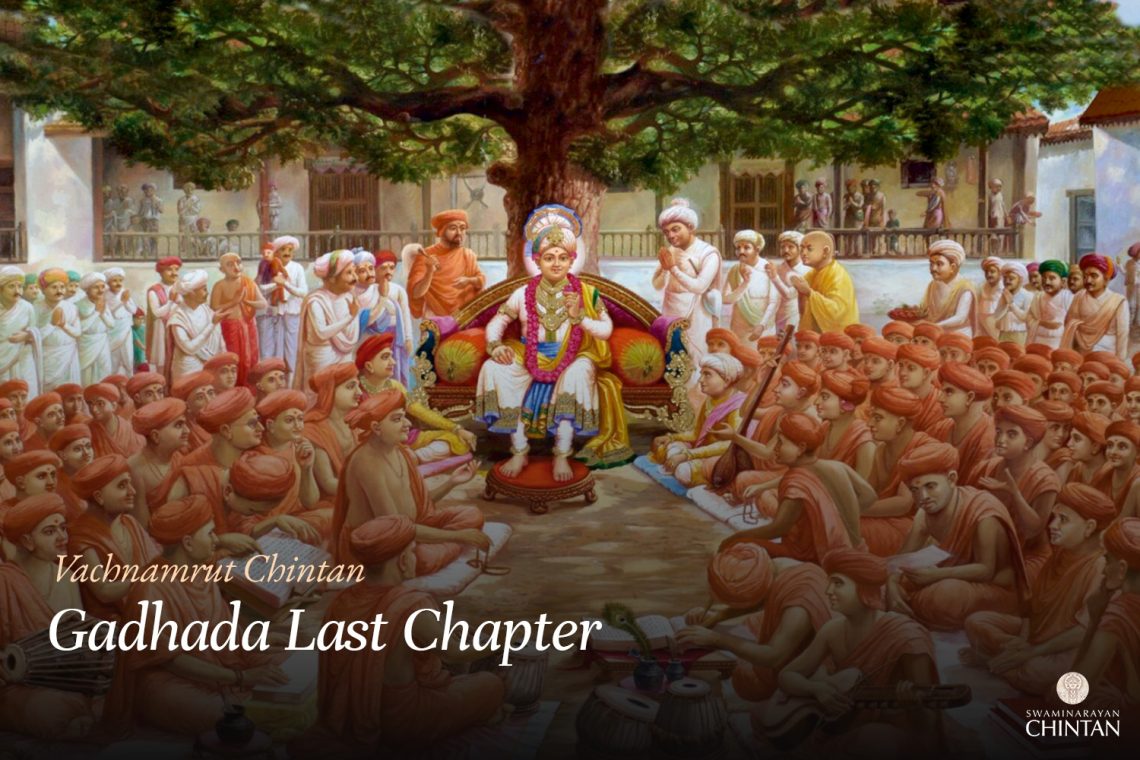Central Insights:
- The Gateway of Jnanpanu
Subject of Discussion:
- Standing guard at the gateway of awareness (Jnanpanu).
Key Points:
- Discrimination (Vivekshakti) is the guiding force on the path to liberation.
- Actions related to Satsang (holy fellowship), if performed with pure intentions, do not obstruct the state of unwavering concentration (Nirvikalp Sthiti).
Explanation:
This Vachanamrut focuses on Jnanpanu (awareness). Shreeji Maharaj addresses all Haribhakto (devotees), stating:
“Our great Paramhansas possess a profound state of awareness and understanding. Listen to my words, and later, express how you practice and maintain your own state.”
Maharaj then elaborates, saying:
“Our Santo remain vigilant at the gateway of divine awareness, which is akin to the gateway to Bhagwan’s Akshardham (divine abode). Through this awareness, they can perceive the divine form of Bhagwan residing in Akshardham. At the same time, they ensure that no worldly distractions—such as Maya (material attachments)—enter their hearts.”
Here, Jnanpanu is defined as an awakened sense of Vivek (discrimination). This Vivek is not merely societal etiquette but the ability to discern the path to liberation. Maharaj emphasizes that Vivekshakti is a unique gift bestowed by Bhagwan upon all humans.
He explains that the great Santo stand alert at this gateway of Vivek like valiant royal guards. Just as such guards armed with shields and swords prevent thieves or troublemakers from entering the king’s palace, the Santo prevent any worldly distractions from infiltrating the sanctity of their hearts, which are devoted solely to Bhagwan. Even amidst endless disturbances—such as gain or loss, honor or insult, happiness or sorrow—they do not waver or lose their vigilance.
Someone may wonder how such a vigilant Sant manages daily activities, such as eating or drinking. Maharaj addresses this concern with two analogies:
- A woman at the edge of a well carefully draws water without falling in.
- A horse rider remains alert, gripping the reins and stirrups firmly while navigating obstacles on the path.
These examples illustrate how Santo maintain unwavering awareness while engaging in necessary worldly activities. Maharaj highlights the state of Nirvikalp Sthiti, explaining how, despite performing worldly functions, the Santo never lose their focus on Bhagwan.
Maharaj then draws an analogy with vigilant royal guards who are ever-ready to combat intrusions while keeping their attention fixed on their duty. Similarly, Nirvikalp Sthiti saints remain steadfast at the gate of awareness, always focused on Bhagwan’s Murti (form). They guard their hearts with a resolve to cut off any impressions (Sanskaras) or desires (Vasanas) contrary to their devotion.
Resolution of a Key Question:
Does engaging in worldly activities conflict with maintaining Nirvikalp Sthiti?
Maharaj provides clarity, stating that the outcome of actions depends on the intentions behind them. If actions are performed with a pure intention, such as enhancing one’s devotion or supporting the progress of Bhakti (devotion), these actions—though involving worldly elements—ultimately aid in attaining Nirvikalp Sthiti.
Even Satsang-related activities performed with noble intent facilitate spiritual progress rather than hinder it. Maharaj concludes by emphasizing that the great Paramhansas, despite engaging in such activities, remain steadfast in their Nirvikalp Sthiti and ensure they do not falter from their elevated spiritual state.
Glossary
| Jnanpanu – Awareness |
| Vivekshakti – Discrimination |
| Nirvikalp Sthiti – State of unwavering concentration |
| Akshardham – The eternal supreme abode of Bhagwan Swaminarayan The divine realm where Bhagwan Swaminarayan resides along with Akshar Muktas (Divine Liberated Souls) |
| Murti – Divine form of God Refers to Bhagwan’s physical or imagined divine form, which provides joy and spiritual connection during contemplation. |
| Maya – Illusion The material energy that entangles the Jeev in worldly existence and distracts from Bhagwan. |
| Sanskaras – Impressions Subtle, accumulated tendencies and habits shaped by past actions and thoughts. |
| Vasanas – Desires |
| Satsang – Holy fellowship |
| Paramhansa – Supreme Renunciates A highly evolved saint who has renounced all worldly attachments and is solely devoted to God. |

